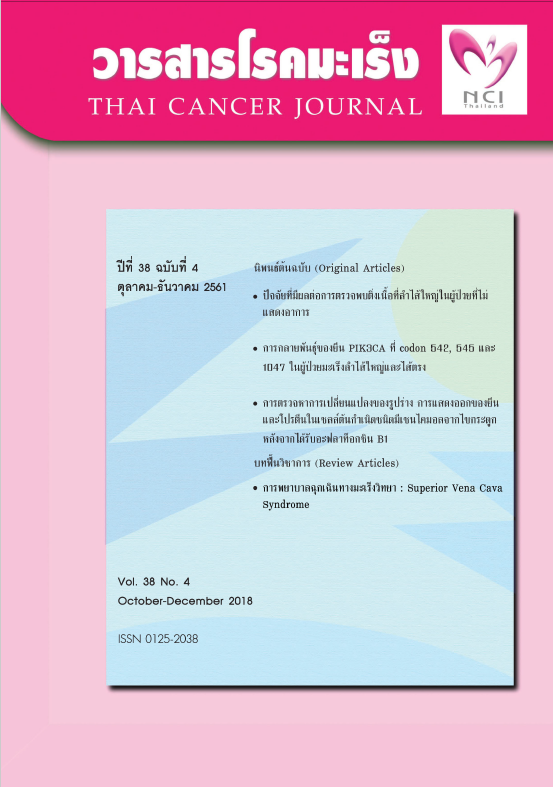Emergency Nursing in Medical Oncology: Superior Vena Cava Syndrome
Keywords:
superior vena cava syndrome, emergency nursing, cancerAbstract
An oncologic emergency is classified as a rare occurrence; however, it is a potentially morbid or life-threatening event, both directly and indirectly related to the patient's health. Giving patients inpatient treatment with rapid and intense frequency will improve their chances of prevention, cure and relief. Superior Vena Cava Syndrome (SVCS) is an emergency related to medical oncology, since it is mostly found in lung cancer; it is defined as a group of symptoms caused by obstruction of the superior vena cava (a short, wide vessel carrying circulating blood into the heart). SVCS associated with this cancer results from a tumor growing inside the blood vessel resulting in a vascular blockage and disease in that part of the body. Patients with SVCS are usually fatigued due to the difficulty of breathing or from shortness of breath, and often present with facial, neck and arm swelling. Stridor may be detected from proximal airway edema or obstruction. SVCS affects the cardiovascular system by causing hypotension, diseases of the nervous system (such as headache, amblyopia, seizure, and altered consciousness). Awareness of this medial emergency will aid in the preparation of efficient and effective treatment, since SVCS is considered a potentially life-threatening medical emergency
References
โกสินทร์ วิระษร. ภาวะฉุกเฉินทางมะเร็งวิทยาที่พบบอ่ย. ศรีนครินทร์เวชสาร 2558;30:200-11.
มานพ พิทักษ์ภากร, รัตนา ชวนะสุนทรพจน์, สุรัตน์ ทองอยู่, มณฑิรา มณีรัตนะพร, ณสิกาญจน์ อังคเศกวินัย, บรรณาธิการ. อายุรศาสตร์ทันยุค 2559. นนทบุรี: ภาพพิมพ์; 2559.
Baruah M. Oncologic emergencies: a review. Int J Res Med Sci 2018;6:1484-90.
Lai CH, Chang WC, Liu TJ, Lee WL, Su CS. Endovascular treatment of concomitant obsruction of a denver drainage catheter and superior vena cava in a patient with liver cirrhosis. Int Heart J 2017;58:1-4.
Tanigawa N, Sawada S, Mishima K, Okauda Y, Mizukawa K, Ohmura N, et al. Clinical outcome of stenting in superior vena cava syndrome associated with malignant tumors. Acta Radiol 1998;39: 669-74.
Rice TW, Rodrigez RM, Light RW. The superior vena cava syndrome:clinical characteristic and evolving etiology. Medicine 2006;85:37-42.
Kuo TT, Chen PL, Shih CC, Chen IM. Endovascular stenting for end-stage lung cancer patient with superior vena cava syndrome post first-line treatments-a single-center experience and literature review. JCMA 2017;20:1-5.
Rizvi AZ, Kalra M, Bjarnason H. Benign superior vena cava syndrome: stenting is now the first line of treatment. J Vasc Surg 2008;47:372-80.
Wilson LD, Detterbeck FC, Yahalom J. Superior vena cava syndrome with malignant causes. N Engl J Med 2007;356:1862-9.
McCurdy MT, Shanholtz CB. Oncologic emergencies. Crit Care Med 2012;40:2212-22.
Walji N, Chan AK, Peake DR. Common acute oncologic al emergencies:diagnosis, investigation and management. Postgrad Med J 2008;84:418-27.
Behl D, Hendrickson AW, Moynihan TJ. Oncologic emergencies. Crit Care Clin 2010;26:181-205.
Lanciego C, Pangua C, Chacon JI, Velasco J, Boy RC, Viana A, et al. Endovascular stenting as the first step in the overall management of malignant superior vena cava syndrome. JR 2009;193:549-58.
Flounders JA. Superior vena cava syndrome. OMF 2003;30:E84-E90.
Juan YH, Saboo SS, Anand V, Chatzizsis YS, Lin YC, Steigner ML. Superior vena cava syndrome associated with right-to-left shunt through systemic-to-pulmonary venous collaterals. Korean J Radiol 2014; 15:185-7.
Downloads
Published
Issue
Section
License
บทความทีตีพิมพ์ในวารสารโรคมะเร็งนี้ถือว่าเป็นลิขสิทธิ์ของมูลนิธิสถาบันมะเร็งแห่งชาติ และผลงานวิชาการหรือวิจัยของคณะผู้เขียน ไม่ใช่ความคิดเห็นของบรรณาธิการหรือผู้จัดทํา







